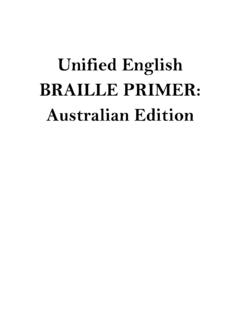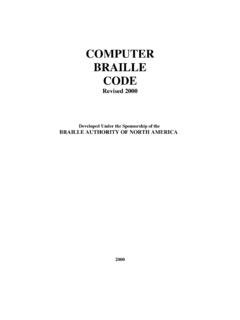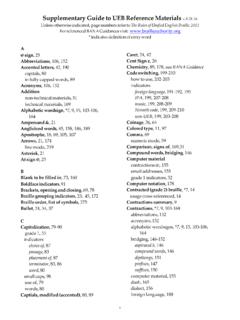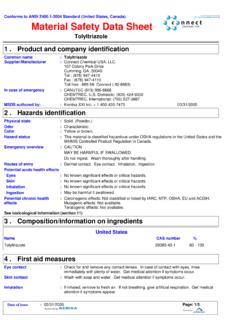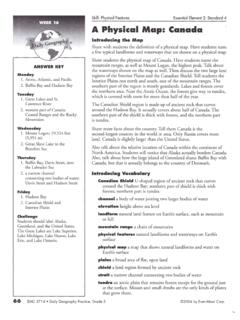Transcription of Size and Spacing of Braille Characters
1 Size and Spacing of Braille Characters Braille is a system of touch reading and writing used by blind persons. Embossed dots are evenly arranged in quadrangular letter spaces, called cells. A full cell is three dots high and two dots wide. Each cell may contain up to six dots. Only 63 different Characters can be formed. Braille is a fixed-width font meaning that every character occupies the same amount of space, regardless of how many dots are in the cell. For Braille to be read by a blind person, the dots of each cell must be easily discernible by touch and the height of the dots must be sufficient to be easily distinguished from the background.
2 Standards for Braille Embossed on Paper Every major Braille -producing country has standards for the size and Spacing of Braille embossed on paper. In the United States and Canada, the de facto standard is the values put forth in Specification 800, " Braille Books and Pamphlets," from the National Library Service for the Blind and Physically Handicapped of the Library of Congress. Section of Specification 800 ( Braille Books and Pamphlets) February 2008 reads as follows: Size and Spacing The nominal height of Braille dots shall be inches [ mm] and shall be uniform within any given transcription.
3 The nominal base diameter of Braille dots shall be inches [ mm]. Cell Spacing of dots shall conform to the following: The nominal distance from center to center of adjacent dots (horizontally or vertically, but not diagonally) in the same cell shall be inches [ mm]. The nominal distance from center to center of corresponding dots in adjacent cells shall be inches [ mm]. The nominal line Spacing of Braille cells from center to center of nearest corresponding dots in adjacent lines shall be inches [ cm].
4 Standards for Braille Signage The standards for creating Braille suitable for signage have evolved away from those for paper. There is no one standard for Braille on signage. Many states have created their own specifications as part of their state building codes; and, while Braille size and Spacing requirements are part of the Americans with Disabilities Act (ADA), updated standards, based on the International Building Code, have been in process for nearly fifteen years. More detail on the most common standards and their origins is provided below.
5 The Access Board is responsible for developing guidelines for the implementation of the ADA. The first Americans with Disabilities Act Accessibility Guidelines (ADAAG) were published in 1991. In Section of this document, the parameters for the size and Spacing of Braille Characters , even though they were being applied to Braille signage, were exactly the same as those from the Library of Congress for Braille embossed on paper. Updated guidelines, called the ABA and ADA Accessibility Guidelines, were published by the Access Board in 2004 and the specifications for Braille sizing and Spacing were changed significantly.
6 The dimensions required in section of the new document are exactly the same as those found in ANSI's International Building Code. These are also the first guidelines from the Access Board that specifies that dots should be domed . To become legal requirements, the guidelines from the Access Board must be approved by the Department of Justice; and these new guidelines, issued in 2004, have not been approved. As of August 2009, the original ADAAG still stands as the enforceable requirements for much of the country.
7 Individual states have the right to determine their own laws on subjects not specifically mandated by the federal government and may also exceed federal mandates where they exist. State regulations regarding the ADA must be approved by the Justice Department and must meet at least the minimum standard of the federal mandate. Because the 2004 guidelines are still not approved, the last federal ADA mandates date to 1991, so many states have established or updated their regulations in the interim. The earliest state to establish its own Braille standards was California.
8 Recognizing that existing standards were based on the optimal character size and Spacing for Braille material embossed on paper, California, when including Braille specifications in its state building code for signage, created what is known today as California Braille . In 1980, the California legislature passed a resolution requiring "that all designers and manufacturers of Braille tactile signage that contract with the State of California shall comply with the California Building Code when designing, developing, manufacturing, or implementing Braille tactile signage".
9 Section of the California Code of Regulations, Title 24, the California Building Standards Code is as follows: Braille . Contracted Grade 2 Braille shall be used wherever Braille is required in other portions of these standards. Dots shall be 1/10 inch ( mm) on centers in each cell with 2/10-inch ( mm) space between cells, measured from the second column of dots in the first cell to the first column of dots in the second cell. Dots shall be raised a minimum of 1/40 inch ( mm) above the background.
10 Braille dots shall be domed or rounded. In the California standard, the parameters of the dot size and Spacing are much greater than that of dots on paper. A requirement for rounded dots was included in these requirements in an effort to reduce vandalism and improve readability. In 1998 and updated in 2003, the American National Standards Institute put forth similar standards in American National Standard: Accessible and Usable Buildings and Facilities: 2003: Standard and Commentary . Again, the dimensions for Braille Characters intended for Braille on signs are much larger than typically used for Braille on paper but in these standards, a range of measurements is specified rather than a specific value.







